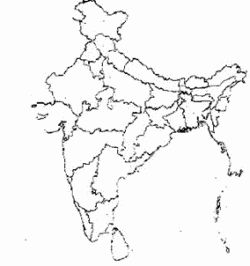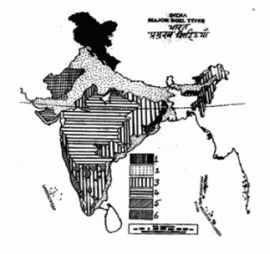(Paper) National Institute of Open Schooling (NIOS) | Class XI Sample Question Paper - Social Science (213)
Disclaimer: This website is NOT associated with CBSE, for official website of CBSE visit - www.cbse.gov.in
National Institute of Open Schooling (NIOS) | Class XI Sample Question Paper - Social Science (213)
Sample Question Paper
Social Science (213)
Time: 3 hours
Maximum Marks : 100
Note: (i) All questions are compulsory. Marks are indicated against each question.
1. In the given outline map of India mark and label the following: 2
i) A union Territory having the highest density of population.
ii) A metropolitan city having the largest population

2. Write in your answer book the correct names of the major soil types shown in the map by shades 2, 3, 4 and 6. 4

3. Which one of the following states has the highest proportion of urban population in its total population? 1
(a) Maharashtra
(b) U.P.
(c) Kerala
(d) Mizoram
4. The word “Democracy” has originated from which language? Select the correct alternative. 1
a) Latin
b) French
c) German
d) Greek
5. Which one of the following is the natural habitat of rhinoceros in India? 1
(a) Hot-wet forests of Kerala
(b) Desert areas of Rajasthan
(c) Arid areas of Rann of Kachchh
(d) Swampy lands of Assam
6. What was the real motive of the British in the Partition of Bengal in 1905? 1
(a) Administrative convenience
(b) Spreading nationalist feeling in Bengal
(c) Checking the occurrence of famines in Bengal
(d) To suppress the growth of nationalist feeling in Bengal
7. The reason for the failure of the League of Nation was that: 1
a) It had too many members
b) It had no administrative body
c) It had no constitution to define the powers of various organs
d) It had no army to enforce its decision
8. Which of the four cities situated on the bank of the Yamuna river is a holy city of the Hindus. 1
a. Delhi
b. Mathura
c. Agra
d. Hamirpur
9. How can the U.N. Security Council deal with an act of aggression against one of the U.N. members? 1
a) It may let the victim fight its own battle.
b) It may let the victim seek help of any big power
c) It may ask regional organisation to arrange the defence of the victim.
d) It may ask member countries to apply collective security measures of military sanctions.
10. Which one of the following is the first country in the world to have a national population policy? 1
(a) USA
(b) Russia
(c) India
(d) China
11. Mention two epics which are remembered as outstanding contributions of Ancient Greek in the field of literature. 1
12. Which hemisphere has the larger extent of Indian Ocean? 1
13. The treaty of Versailles contained the seed of the Second World War justify the statement in brief. 1
14. After being passed by Loksabha, a Money Bill is sent to Rajya Sabha for consideration on 2nd September. The Rajya Sabha takes no action till the end of the month. What will be the fate of the bill? 1
15. List four main features of the Renaissance period? 4
16. Name any eight factors which influence the climate of India? 4
17. Define sex ratio. Describe any three factors responsible for the decline in sex ratio in India? 4
18. Mention any four Directive Principles of State Policy that promote the establishment of economic democracy? 4
19. Mention any four ways by which the Lok Sabha keeps a check on the Council of Ministers? 4
20. Why did the Renaissance begin in Italy? 4
21. Define the terms jet stream and wind. Give one point of similarity and one point of difference between them? 4
22. Explain four reasons which are responsible for the rapid population growth in India? 4
23. Explain any four factors responsible for the growth of national consciousness in India? 4
24. Write four differences between union and state list? 4
25. How do illiteracy, poverty and communalism act as hindrances in the formulation of sound public opinion? Explain. 4
26. Explain India’s nuclear policy of no first use? 4
27. Explain India’s policy in regard to racial discrimination? 4
28. Was the Indo – Soviet Treaty of Friendship of 1971 against the principles of non- alignment? Support your answer giving three reasons? 4
29. Analyse any four post Second World War developments that accelerated the process of Indian Independence in 1947? 4
30. A person encourages untouchability while working in a public office. Which fundamental right is violated and how? 4
31. Mention any six contributions of Rama Krishan Mission & Swami Vivekananda to Indian society? 6
32. Examine the major cause of the Second World War? 6
33. How is the Vice President of India elected? Explain three of his functions. 6
